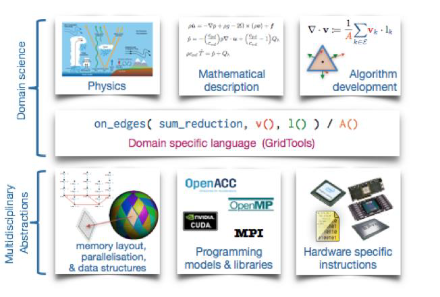Service Navigation
Search
Europe's proven and fastest algorithms for numerical weather and climate prediction, including both ocean and atmosphere components, represent substantial financial and intellectual investments, often in the form of up to millions of lines of code. Substantial progress has been made in improving the scalability of these codes which has enabled Europe's first ever prototype global kilometre-scale simulations. This capability is expected to eliminate climate uncertainty associated with parametrised processes such as clouds and convection (Schneider et al. 2017).
But fundamental changes are required to enable optimisation and adaptation for emerging HPC architectures as well as to obtaining further increases in parallelism towards exascale.
The ESCAPE project is addressing this issue on so-called weather and climate dwarfs that allow to focus adaptation and optimisation on very specific compute and data movement patterns. Dwarfs represent the wide range of different domain specific algorithms that are key components of weather and climate models, and they contribute significantly to the overall workload.
MeteoSwiss develops with partners of the project a novel high-level DSL toolchain that will be demonstrated on the dwarfs of the project.

The DSL provides a separation of concern between the mathematics and algorithms of the weather model layer and the efficient implementation and optimizations for a computing architecture. This allows model developers to focus on the scientific development by utilizing a simple language (similar to Matlab) while the software of the project takes care of optimizing the code for large supercomputing systems.
The project has a strong focus on modern accelerators and graphical processing unit devices (GPUs) which are the operational computing devices of the current operational system for the COSMO-1E weather forecast of MeteoSwiss.